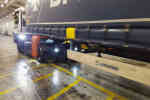Step 2 of 3•5 minutes read
Cargo Securing Methods Used Onboard
There are many methods to use to prevent cargo shifting. There are advantages and disadvantages to each method and in some cases, the most efficient solution is a combination of different methods. In this section, the following primary methods for cargo securing are presented:
- Blocking arrangements.
- Locking arrangements.
- Straight and crossed lashings.
- Loop lashings.
- Top-over lashings.
Blocking Arrangements
When a unit is stowed so it cannot move, for example, against other cargo, the ship's main structure or container walls, the cargo unit is considered blocked. When a unit has its centre of gravity located below the top of the external blocking arrangement, it is effectively prevented from sliding and tipping. However, occasionally a cargo unit is blocked at the bottom only and thus only sliding is prevented. To prevent tipping in such cases, other cargo securing methods might be considered in combination with the bottom blocking.

Example of blocking of wooden boxes on a flat rack with wooden bracings in both longitudinal and transverse directions

Paper reels that are blocked against each other and the vessels superstructure
Locking Arrangements
For some units, it is possible to lock them to the ship's main structure mechanically. The most commonly used type of such equipment is twist locks intended for containers. Locking may also be achieved by welding a unit to the deck or any other main structural part of the ship, as is sometimes done with heavy project cargoes. Some RoRo vessels have been equipped with trestles that can mechanically lock trailers to the deck.

Locking containers on board a container vessel with twist locks

Trailer trestle that is mechanically locked to the deck of a RoRo vessel
Straight and Crossed Lashings
Straight or crossed lashings are used when the lashing can be attached directly to dedicated lashing points on both the cargo unit as well as in the deck of the vessel. These types of lashings are very efficient since movements are not possible unless the lashings or lashing point break.
When applying straight lashings, it is always important to consider the lashing angles. For example, if the lashings are applied in a cross, they are more effective in preventing sliding than tipping, while the opposite is true for straight lashings attached at the side of the cargo and pulling straight downwards.

Example of straight and crossed lashings used to secure cargo to a roll trailer

Example of straight lashings used to secure cargo to the vessel
Loop Lashings
Loop lashings are attached in pairs so that two lashings are placed around the unit, each lashing with both ends fastened at the same cargo side. Loop lashings secure cargo from moving sideways, and each lashing within a pair works independently of the other. Loop lashings have limited effects on forward and rearward movements.
Cargo secured by loop lashings will not be able to move in transverse directions unless the lashing or lashing points break.

Example of loop lashings used to secure cargo on a roll trailer

Example of loop lashings used to secure cargo inside a container
Top-Over Lashings
Top-over lashings are used for increasing the contact force between cargo and the underlying surface, the deck, for example. By this fact, sliding is prevented by the increased friction force only and not directly by the lashings themselves. How great the contact force can be, depends on the tension in the lashing and the friction between the materials used.
It is also important to point out that the lashing angles have a great impact on how successful a securing arrangement will be. Lashings placed at 90 degrees angles toward the deck are the most efficient, but if the angle decreases, the efficiency of the lashing will decrease as well.

Example of top-over lashings used to secure cargo to a container flat

Example of top-over lashings used to secure cargo inside a container
Summary
Securing loose cargo or CTUs on board the vessel should be done according to the instructions given in the vessel's Cargo Securing Manual (CSM). The grade of securing (number of lashings etc.) found in the CSM is the expected acceleration that may affect the cargo depending on the location on board the vessel (for example, lower hold, main deck, upper deck or weather deck). The calculation of these accelerations is based on the vessel's particular characteristics (length, breadth, speed and max GM) and gives maximum accelerations that can arise during a sea voyage.
When considering how the cargo should be properly secured on a cargo transport unit (CTU), several things have to be considered. This includes expected sea area, kind of CTU that will be used, physical dimensions, weight and centre of gravity of the cargo, and eventual lashing points on the cargo together with which lashing material(s) to be used for the cargo securing. Once all this data is known, the determination of the most suitable securing methods to prevent sliding and tipping of the cargo can be done. Usually, the best securing method is to block stow the cargo. If this is not possible or if the cargo can't be blocked so that it prevents both sliding and tipping, one of the lashing methods needs to be used. The CTU Code and the quick lashing guides are very helpful tools for cargo securing in CTUs.